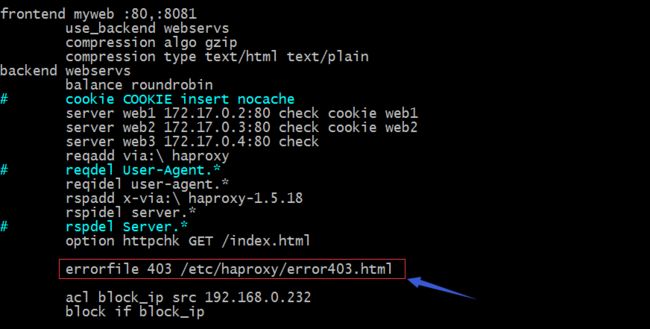前文我们聊了下haproxy的修改报文首部的配置、压缩功能以及haproxy基于http协议自定义健康状态检测机制;回顾请参考https://www.cnblogs.com/qiuhom-1874/p/12789175.html;今天这篇博客主要来说一下haproxy的错误页面定义,日志相关配置;
首先来说说错误页面的配置吧;haproxy同nginx是一样可自定义错误页面;在nginx里我们用error_page 指令来指定对应错误状态码加location,根据错误状态码指定的location来指定对应错误状态码的状态页面文件;haproxy自定义错误页面的思想类似,不同的是nginx作为web服务器可以自定义404错误页面,而haproxy通常作为代理服务器,对于404错误页面通常不会由haproxy自己指定,因为haproxy作为代理服务器对于后端server的资源是否能够找到,它不知道;即便我们在配置中指定了404错误对应的响应页面,在haproxy重启后是不会生效的;haproxy指定错误页面的方式两种,第一种是指定本地文件系统文件作为对应错误状态码的错误页;第二种是指定对应错误状态码跳转的URL;
errorfile
示例:自定义错误403的错误页面
提示:为了能够模仿出403错误,上面使用了acl来拒绝源地址为192.168.0.232的访问;后面我们会说acl的用法;上图红框中的内容就是表示对于错误403响应页面上/etc/haproxy/error403.html;
测试:在192.168.0.232主机上用浏览器访问haproxy对外提供服务端接口,看看是否响应我们自定义的页面?
提示:从上面的测试结果看,haproxy是能够把我们指定错误状态码对应文件内容响应给我们;这里挺奇怪的在消息头里只看得到请求报文,没有响应报文;
示例:指定403错误页面跳转至nginx.org/aaa.html
提示:红框中的配置就表示对于403错误就跳转到指定http://nginx.org/aaa.html
测试:在232主机上访问192.168.0.22看看是否跳转到nginx.org/aaa.html?
提示:errorloc和errorloc302都是同样的效果,都是以临时重定向到指定的url上;这里还需要注意一点,这两种方式都是跳转前请求的方法是什么,跳转对应url也是同样的方法;这样一来对于其他非GET方法请求出现403错误码的时候,对应的错误页就无法正常处理(通常只允许GET方法去请求别的URL);比如跳转前用PUT方法,出现错误403后,按照上面的配置,对应指定的错误页的url也会用PUT方法去请求;为了解决这样的问题,我们这里需要用到errorloc303来指定;该指令的意思是返回303响应码;如果请求前非GET方法,而出现对应错误后,用GET方法去请求对应错误状态码指定的URL;
示例:非GET方法错误页面重定向到其他URL上
提示:以上配置就表示如果我们用非GET方法请求某资源,出现403错误后,返回303状态码;303表示请求重定向页面的方法要总是使用GET方法;
测试:先使用errorloc302指定url跳转,然后在浏览器上跳转前使用PUT方法请求,看看跳转后到指定URL看看使用的什么方法?
提示:可以看到当我们用PUT方法请求192.168.0.22时,跳转到指定的URL也是用的PUT方法;
测试:用errorloc303指定跳转url,然后用PUT方法请求192.168.0.22看看跳转URL使用什么方法?
提示:可以看到用errorloc303指定错误url后,跳转指定URL不是跳转前的PUT方法请求,而是GET;
以上就是haproxy关于错误页面的定义的配置,更多说明请参考官方文档http://cbonte.github.io/haproxy-dconv/;说了haproxy的错误页面配置后,接下来在来了解下haproxy的日志;
log:启用事件和流量的每个实例日志记录。
no log:关闭日志记录;
log global:调用全局配置段中日志的定义;
log
[len log-format
+---+------+-----------------------------------------------+-------------+
| R | var | field name (8.2.2 and 8.2.3 for description) | type |
+---+------+-----------------------------------------------+-------------+
| | %o | special variable, apply flags on all next var | |
+---+------+-----------------------------------------------+-------------+
| | %B | bytes_read (from server to client) | numeric |
| H | %CC | captured_request_cookie | string |
| H | %CS | captured_response_cookie | string |
| | %H | hostname | string |
| | %ID | unique-id | string |
| | %ST | status_code | numeric |
| | %T | gmt_date_time | date |
| | %Tc | Tc | numeric |
| | %Tl | local_date_time | date |
| H | %Tq | Tq | numeric |
| H | %Tr | Tr | numeric |
| | %Ts | timestamp | numeric |
| | %Tt | Tt | numeric |
| | %Tw | Tw | numeric |
| | %U | bytes_uploaded (from client to server) | numeric |
| | %ac | actconn | numeric |
| | %b | backend_name | string |
| | %bc | beconn (backend concurrent connections) | numeric |
| | %bi | backend_source_ip (connecting address) | IP |
| | %bp | backend_source_port (connecting address) | numeric |
| | %bq | backend_queue | numeric |
| | %ci | client_ip (accepted address) | IP |
| | %cp | client_port (accepted address) | numeric |
| | %f | frontend_name | string |
| | %fc | feconn (frontend concurrent connections) | numeric |
| | %fi | frontend_ip (accepting address) | IP |
| | %fp | frontend_port (accepting address) | numeric |
| | %ft | frontend_name_transport ('~' suffix for SSL) | string |
| | %hr | captured_request_headers default style | string |
| | %hrl | captured_request_headers CLF style | string list |
| | %hs | captured_response_headers default style | string |
| | %hsl | captured_response_headers CLF style | string list |
| | %ms | accept date milliseconds (left-padded with 0) | numeric |
| | %pid | PID | numeric |
| H | %r | http_request | string |
| | %rc | retries | numeric |
| | %rt | request_counter (HTTP req or TCP session) | numeric |
| | %s | server_name | string |
| | %sc | srv_conn (server concurrent connections) | numeric |
| | %si | server_IP (target address) | IP |
| | %sp | server_port (target address) | numeric |
| | %sq | srv_queue | numeric |
| S | %sslc| ssl_ciphers (ex: AES-SHA) | string |
| S | %sslv| ssl_version (ex: TLSv1) | string |
| | %t | date_time (with millisecond resolution) | date |
| | %ts | termination_state | string |
| H | %tsc | termination_state with cookie status | string |
+---+------+-----------------------------------------------+-------------+
capture cookie
capture request header
capture response header
结合上面的内容,我们就可以自定义访问日志了;通常我们通过capture去捕获对应首部的信息,然后通过上面的变量定义成日志格式
示例:
测试:用浏览器访问对应haproxy的前端,看看日志格式
![]()
提示:可以看到我们访问对应haproxy的前端,日志就和默认的日志不一样了;日志格式中的变来可参照上边的表去找对应表示什么;







